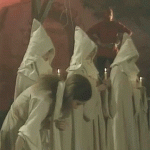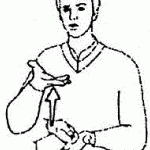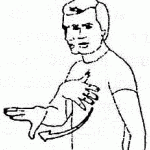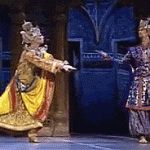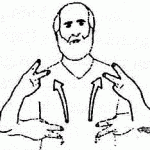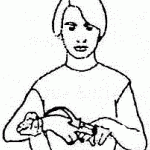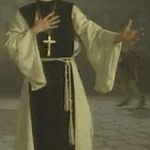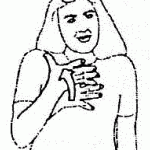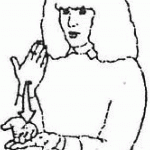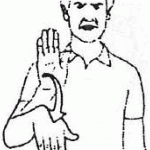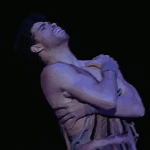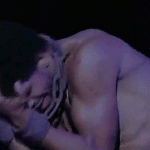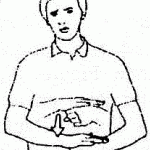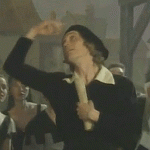Abstract:
The body is the crossroad of the biological and cultural (representational) experience of human being. It has a basic rhetoric potential, which is exploited, in various cultures, through both verbal and non-verbal communication. As a proof, Lakoff’s and Johnson’ s concept of “orientation metaphor”, able to transpose certain concepts into space, as well as Fontanier’s “metonymies of the physical”, or Greimas’ “metonymic actors” identified in the bodily segments and acting each “in the name of an actant” (Greimas). Therefore, the body is an “expressive space” (Merleau-Ponty), the symbolic value of its segments being deeply involved in choreographic significations.
Key-words: gestual language, orientation metaphor (Lakoff & Johnson), metonymies of the physical (Fontanier), metonymic actors (Greimas), verbal/ non verbal communication, dance.
Acknowledgements:
I would like to offer my special thanks to “Gabriela Tudor” Foundation from Bucharest (Romania), the coordinator of the project “E-Motional: re-thinking dance (2013-2015)”, and to the “George Apostu” Cultural Centre from Bacău (Romania), partner in this project, for facilitating my documentation and research. Also, my special thanks are extended to other partners and associated partners within this project: Association of Professional Contemporary Dance Choregraphers from Riga (Latvia), “Fábrica de Movimentos” Associação Cultural from Porto (Portugal), Centre de Création Chorégraphique “Trois C-L” from Luxembourg, Faculty of Letters from “Vasile Alecsandri” University (Bacău, Romania). The project “E-Motional: re-thinking dance (2013-2015)” is supported by the European Commission and the Romanian Ministry of Culture.
1. “Metonymies of the physical” in (non)verbal communication
It is almost a truism to say that the body is a means, even an aspect of the expression. The body has a basic rhetoric potential, which is exploited, in various cultures, through both verbal and non-verbal communication. Moreover, Greimas identifies “metonymic actors” in the bodily segments. Before him, Fontanier had already highlighted the “metonymies of the physical” . This means that different languages and cultures often associate feelings, emotions, skills, moral qualities in general with certain parts of the body. Thus, the latter have become some sort of somatic label, the “sign” of the former. As a proof, the heart , involved almost everywhere, embraces generously the emotional horizon, being associated with “courage”, “noble and elevated feelings”, “love”; while head is connotatively connected to contents such as “mind, spirit, reason”, “opinion”, “fads”, “fantasy”. Besides what they are hearing, the ears “say” ¨C in some languages ¨C quite a lot of things: attention, compassion, trust etc. Therefore, the body is an “expressive space”, its main “regions” being established for certain actions “to the value of which they contribute” [unless indicated otherwise, all translations are mine] . But the body is not just any “space”; it is the source of the “other” spatialities. More precisely, the subject is established as a benchmark for his relations with the world. Merleau-Ponty summarizes this in a memorable phrase: the body is a “means” of “having a world” :
“Sometimes, it is restricted to the gestures needed to preserve life and, together with these, they establish around us a biological world; at other times, using these first gestures and passing from their proper to their figurative meaning, it manifests, through their mediation, a new nucleus of signification” .
This is just what happens in dance and other artistic “languages”, able to “culturalize the natural”, as Barthes said, otherwise to introduce a semantic shape in the fleshing life and feelings. Ernst Cassirer reproaches Kant the fact that he was allegedly interested only in the “intellectual sublimation of experience” . Merleau-Ponty retains the idea and consolidates its arguments. In his opinion, the motor experience of one’s body “provides us with a way of accessing the world”, a “praktognosis recognizable as original and perhaps primordial”; moreover, the body “understands its world without passing through representations, without subordinating itself to a symbolic or objectifying function” . This means that motricity has the ability to confer meaning in an unmediated way. This supports the distinction drawn by Merleau-Ponty between “intellectual” and “motor” signification. The latter is relevant for the “motor subject” and connected to “considering a movement as an effective movement” . It resembles “physiological judgment”, as described by Leroi-Gourhan . Similarly, Rudolf Laban draws the distinction between “thinking through words” and “thinking in terms of movement”, which essentially joins Merleau-Ponty’s distinction. “Motor thinking” consists of an “accumulation of impressions of events” ; for something like this, there may be no verbal expression. Thinking “through words” serves the orientation in the external world. The “motor” one seems to Laban as appropriate for “orientation in the inner world” . Through its impulses, the latter nourishes practical action and play alike.
The symbolic value of the body segments is deeply involved in building choreographic significations. Thus, in the 19th century, François Delsarte’s observations anticipated relevant innovations in the pedagogy of bodily expression. They would occur particularly at the border between the 19th and 20th centuries, along with the forefathers and founders of the modern dance. According to Delsarte, the body may be described ¨C “morphologically disarticulated”, as Greimas will say ¨C according to three categories: intellectual, “emotional-spiritual” and physical. Thus, the body is semantically structured into three “zones”: “mental” (the head and neck), “spiritual-emotional” (the torso) and “physical” (abdominal). The symbolic value of the limbs derives, according to Delsarte, from their affinity with the median and inferior segments. Attached to the torso, the arms have “spiritual-emotional” connotations. Attached to the inferior, massive area of the body, the legs have a “predominantly physical quality”. Each of these components is a triadic hierarchy. The upper, “massive” part of the arm is “physical”. The forearm is “spiritual-emotional”. Whereas the hand is “mental”. The thigh is “physical”, the shank, “spiritual-emotional”. And the foot ¨C inevitable hilariousness ¨C “mental” . Such a symbolic investment obviously relies on the categorization of bodily actors according to a psych-somatic criterion.
In motion, the partial contributions of bodily “actors” converge towards an “ensemble project” . In order to study it, Greimas proposes, as algorithm, a “morphological disarticulation” or, rather, a semio-morphological one. It consists in delimiting the units (bodily segments) that are pertinent for a semiology of dance. Through descriptive destructuring, the body is revealed like an “ensemble of metonymic actors (arm, leg, head, body etc.)”. These act “more or less by proxy, each in its own partial space, in the name of an actant” . Thus, the bodily discourse is dramatized. The heterogeneous multiplicity of actoriality is subordinated to the coherence of an actantial scheme, which is relevant for what Greimas calls an “ensemble project” . The dialogue of the “metonymic actors” may be polemic or cooperative. Here is one simple example of polemic “dialogue”: in a dance sequence, the body moves forward, the head turns backwards, and the arms stretch backwards, eventually towards a stage partner, from whom the dancer moves away. Useful for analysis, “morphological disarticulation” comes yet across an impediment. It is highlighted by Saussure who related this to verbal language: delimiting the elementary units. Greimas here admits variations determined by the cultural specificity: “morphological disarticulation” is not an immediate and obvious given; like any division of the body into its organs it is, at the same time, natural and cultural . The body is exploited differently, according to the semantic and motor potential of its constituents: from academic ballet to (post)modern dance, from western ballet to Indian classic styles, from folk dance to “society dance”, from outdoor parties to stage.
Thus, for Isadora Duncan, the solar plexus is the bodily abode of the “soul” and the relay where the inner impulse is transposed into movement . The torso is, she believes, the motor and visual centre of the dance movements . Following Isadora, modern choreographers will regard the torso and the pelvis as kinesic “centres”. According to Rudolf Arnheim, dance centred on the torso reveals the performer as a “child of nature”. Movement springs from the torso: its action appears as guided by the nervous vegetative functions, not by the intellect’s cognitive skills . In this case, the entire body moves, not just isolated actors such as the head, neck or arms: thus, the centre of the dancing action (the torso) and the centre of psycho-somatic control (located in the head) remain distinct . Although coordinated by the central nervous system, the movement then springs ¨C as Arnheim observes ¨C from its motor centres located in the torso, not from the level of the head and neck. It is a capital lesson, upon which Isadora Duncan insisted as a dancer as well as pedagogue. Sometimes, the performer dispenses with the rest of the body, using only the hands as an expression instrument. Therefore, dancing may be performed sitting, like Indians occasionally perform it. These are “narrations” with hands’ play, in which the head and face accompany the hands.
There are certain “actions”/ gestures/ fundamental postures able to induce particular significations: “looking”, “open/ closed”, “to concentrate/ to disperse”, etc . They may illustrate the Greimas principle of semio-morphological “disarticulation”, as a premise for constituting kinesic significations. For instance, not only the eye, but also other segments of the body act in relation to an (exterior) interest centre. The movements of the head are often motivated by the desire to turn our face towards what we are interested in looking at. Multiple gestual expressions correspond to certain nuclear figures of the linguistic content. The actions of some bodily actors (palm, sole, stern) may manifest the same gestual figure: looking. The palms and soles “look” (are oriented) in the direction of the object which they want to bring closer (to them) or reject. The kinesic versions of “looking” are a part of the revolving movements of the palms, soles, face or stern. Their revolving axis is related to the direction of looking. The head and the thorax “pivot” around an imaginary axis, which passes through the centre of the moving body part. The foot revolves around the ankle, the palm around the wrist or elbow.
Also, the attitudes of the body originate ¨C not only in dance ¨C in two fundamental actions, as previously said: to focus and to disperse. Ballet has retained and developed some basic forms of movement, some “symbolic actions” . For example, “arabesques” and “attitudes”. Desemantised ¨C or aesthetically resemantised ¨C basic impulses such as (taking into) possession/ repulsion may be found in dance. Between arabesque and attitude, there is the spatial relation between expansion and focalisation, between dispersion and concentration. In them ¨C as Laban writes ¨C “there is nothing left from the original movements” expressing possession and repulsion . Both postures have lost, in ballet, their primary violence. Tempered by the classical bienséances, they now give only the “agreeable image of the spirit’s delight” . But the arabesque and the ballet dancer’s attitude retain yet an “expressive affinity with the actions they come from: they symbolize the same deep urges, but do not signify them” . This means ¨C according to Laban ¨C that a choreographic symbol does not signify “anything that is defined, but generates a great variety of images for the viewer” . In dance, aestheticizing vital impulses is the particularization of a process widely spread in constituting artistic expression forms. Moreover, the “translucidity” of the choreographic symbol ¨C and, hence, its possibility to be understood ¨C is connected to its power of evocation.
The “abstract” signs from the gestual languages of the deaf-mutes may be performed at the level of the forehead, eyes, nose, mouth, teeth, chin, cheeks, elbow, torso. In a common representation, the forehead is the location of intellectual-cognitive processes. The abstract signs performed at its level have a multitude of related meanings : to think, to reflect, to understand, to know, to believe, theory, scholar, to be right, to know, to have an idea, to imagine, intelligent, crazy, to remember, to forget, to dream, to change opinion, capricious, stupid, famous, to warn, to inform, to invent, etc. The localization of all these “abstract” signs is the same; but their gestural signifiers differ in other parameters, such as displaying the hands and/or movement orientation. Thus, the sign to know is “drawn” by twisting the wrist and touching the forehead with four fingers, and to know, by hitting the forehead twice with the fingers, while to forget demands a reverse movement: away from the forehead, with the open palm. The eyes are the “location of attention” . At their level, one gestually articulates to be attentive/ fascinated, to doubt. In a symbolic anatomy , the nose is the centre of perspicacity. At the same time, it is the level of the kinesic signifiers for to lie, gullible, coward, pretentious. Also in the code of the death-mute, the mouth is the “centre of taste and talk” and the articulation location for to prefer, patient, to be forced. The teeth may be the “location of aggression”. For example, they participate in the signifier of jealous. The chin marks a limit, like in the signs glutton and pygmy. The torso is the centre of emotional processes.
The forehead ¨C as noted above ¨C is integrated into kinesic signs related to intellectual activity. Thus, in the ballet Esmeralda , the poet Gringoire draws, his hand next to the forehead, some kind of a visiting card: uninvited guest at the Court of Miracles, he is forced to reveal his identity. His gesture is meant to recommend him as an intellectual, a famous writer. In fact, in the code of the deaf-mute persons, gestual signs from the level of the forehead also send to contents such as famous or scholar.
In the same ballet, in the scene before the kidnapping, Frollo laments with pathetic gestures, performed at the level of the torso. They send to the inner conflict, which defines him as a character. Turned with his back towards the audience, he raises his arms. When facing the audience, he takes his hands to his heart. While lowering them, he comes across the cross hanging on his chest. He holds it in his palm and temporizes, as if undecided between temptation and vow. His body turns to stone. His look is fixed and terrified. His torso passes for the “place of the heart”, the “location of emotional phenomena” . But the elucidation of the signification of a gesture performed at its level demands a relating to the co(n)text, especially a correlation with the face expression and way of movement . In the language of deaf-mute persons, the sign fear is produced by hitting the torso twice with the palm stretched out (evoking the heart beats, a symptom of emotion). In the same code, guilty/ (it is) his fault… is articulated at the level of the liver. This is a common metaphor in many idioms: the liver, “location” of feelings and remorse. As forms and signification, one of Frollo’s gestures in Esmeralda resembles the one accompanying the Confiteor prayer: striking one’s chest while the confession is made (“mea culpa, mea culpa, mea maxima culpa”). Performed at the level of the torso, Frollo’s gestures externalize a dramatic amalgam: passion, fear, remorse.
Rudolf Laban organises the bodily “actions” ¨C in fact, the dynamics of gestuality ¨C into two series: i) “elementary” actions and ii) “derived”. We may consider these to be: i) kinesiological (by analogy with the phonologic from the verbal system) and ii) kinetic (corresponding to the phonetic). In them, we see certain gestual language units, which signify due to the interdependency langue/parole (Saussure) or semiotic scheme/usage (Hjelmslev). Although Laban does not use semiotic concepts, it is clear that between i) and ii) ¨C between “elementary” and “derived”¨C there is a type/token relation.
i) elementary action ii) derived actionsto hitto push, to crowd, to obstructto whipto beat, to lash, to spoutto tapto sting, to shaketo winnowto slap, to leaf to pressto crush, to cut, to squeezeto (en)twistto untangle, to snatchto glide/slideto smooth, to polish, to rubto floatto spread, to caressAs such or as reworked, both series illustrate the possibility of reducing the diverse (kinetic) substance of gestuality to an invariant (kinetological) corpus of minimal figures. The eight actions from the left column are, in fact, the “figures” of some basic movements. The latter are the common expression of both mental and emotional contents, as well as daily activities.
The actors of a drama may be individualized by means of some “effort schemes” , relevant for “motor thinking”. According to Laban, the kinemorpheme to slide is appropriate for a tutelary deity: it creates the impression of timelessness and weightlessness, but is well established like a direction. The gods of death and violent action may be evoked through to hit, to pierce, to crush: direct and decisive actions, they connote an implacable threat. Luminous deities of hope and joy are situated within a rakish kinesic pattern: to winnow/ leaf/ flutter”. Strong, lasting, flexible twisting connotes time and becoming. Sprites and elves have direct, fast and light actions as gestural label . This is how Ariel from Furtuna [The Tempest] is built, a theatre-dance adaptation by Sergiu Anghel, after Shakespeare’s play with the same title. In the same show, Caliban, the “spirit of heaviness”, is built particularly from versions of to hit; and Miranda’s profile is built from vaporous kinesic lines: to float, to flutter.
2. Saussure’s “syntagmatic solidarities” and “associative coordinations” in choreograpic discourse
Verbal language reclaims two types of discrimination: “phonic” (at the level of the expression) and “conceptual” . To the dissociation based on the distinctive ¨C phemic or semic ¨C marks, there may be added specific “associations”, with the effect of echo or ¨C as Saussure says ¨C of “mutual action” . The meaning of a discourse is a “double system”, where the explicit and implicit meet; in other words, within it there converge the “syntagmatic” and “associative” “contiguities” ¨C or “solidarities” . What are these? Due to the “syntagmatic solidarities” , “almost all the units of language depend either on what surrounds them in the spoken chain, or on the successive parts they are made of”. They are doubled by associative “coordinations” (or “series”). According to Saussure, these exist in the subconscious and are built from units which share an element with the syntagm . Delimiting the constituents of a syntagm depends upon the “associative” series. A syntagm ¨C with the above mentioned Saussurean meaning ¨C exists only to the extent in which other forms from the associative series are “floating around” it. The associative halo is the source of a diffuse, connotative semantism . To a good extent, such a multiply evoking semantism circulates the choreographic sign/ discourse.
Saussure takes into consideration the linguistic sign. Later, Jacqueline Robinson deals with what she (and not only she) rather metaphorically designates as “choreographic language”. Among her own observations ¨C without epigonically assuming the Genevese’s theory ¨C, she widens its pertinence to cover dance as well. The signification of movement depends upon “what has happened before” in the kinesic flow and “what is about to happen”. At the level of choreographic semantics, there are operated “selections” and “associations” based on memory . Robinson does not mention whether she has known ¨C directly or through other sources ¨C Saussure’s ideas. In any case, her opinion enables the generalization of an observation which Saussure had formulated regarding verbal communication: our memory keeps in store all the types of more or less complex syntagms, of any type and length; when we use them, it makes the associative groups interfere in order to fix our choice . Changing the idea, “other oppositions” are necessary, so that “another value” may be generated . Thus, the “idea calls not for a form, but an entire latent system”. From it there derive the oppositions needed to constituting the sign ; meaning its differential identity, within a code. (The oppositions may be “syntagmatic” or “associative”). A collapse of the body manifests the signification not only through the referential/evoking relation, but also through an encoded, quasi-systemic dissociation, such as up/down, rise/fall. A choreographic statement builds not only its syntagmatic but also its associative meaning. This is possible by mediating the semantic halo, which is created around the explicit bodily discourse. For instance, each of the expression figures which build a paradigm of the descending vertical contains at least one formant by means of which it brings, “associatively”, in the implicit of the dance, the entire paradigm of the descending vertical. The shared formant may be a kinesic morpheme of collapse/ (down)fall/ weariness/ defense/ humility, one which is translatable ¨C more or less in an inspired way ¨C through the verbal morpheme “down”. Between the bending of the head, the fall of the arms, the bending of the knees, the sagging of the shoulders, the stooping of the back and, eventually, the collapse of the whole body, there is an “associative”/paradigmatic relationship. It may be consolidated by the “syntagmatic” one. Thus, in the ballet Spartacus, a moment of meditation of Phirgia is preceded by a series of movements which connote, through the syntax of similar morphemes, exhaustion and despair: lowering the arms, kneeling, crouching, bending one’s head, hiding it behind one’s arms.
Similarly, the figures from the paradigm of the ascending vertical are mutually evoking, due to the associative relations from the statements in which they occur. The shared morpheme is the raising gesture: in kinesic statements such as raising one’s eyes/ arms/ head, straightening one’s torso and shoulders, standing on tiptoe, opening one’s palms upwards. In several sequences from the ballet La Bayadère ¨C Rudolf Nureev’s version ¨C, the raising of one’s arms has an ostensive function of indicating/ designating/ presenting. Performed by a humble worshipper, arrived at the temple, the gesture designates the Brahmin. Performed by the priest and the bayadères, around the altar, the gesture is consecrated to divinity. There, it has a double value of call and designation: divinity is called to manifest its benefic effects. Addressed by the courtiers to the rajah, it is, at the same time, a gesture of designation/ presentation and homage. The gestual morpheme of raising one’s arms also occurs in the second act, where a woman announces the arrival of the Brahmin: she points to the door, in the frame of which he has not yet appeared; then, she raises her arms towards the sky. Each time, the co(n)text imposes the particular value of the sign, within the limits of its generic semantism. In the first case, raising one’s arms is integrated into a gestual program with the meaning of “paying homage” (to the High Priest). In the second, within a program with the predication “to invoke”, “to worship” (divinity). In the third, the same morpheme enters the kinesic syntagm “reverential greeting”. In the last example, the respective morpheme has an ostensive-descriptive function. Its role is to specify the identity of the announced person. For this, a special characteristic is selected, which is high Brahmin caste membership. The four programs are constituted around the same kinesic invariant: raising the arms. Here, it induces reference to a certain forme of authority: lay, sacerdotal or divinity itself. (It should be noted here that generally, in associative series, one element “should vary in order to achieve the differentiation characteristic of the studied unit”, with its specificity, as Saussure remarked.)
Above, we have illustrated ¨C and extended to non-verbal communication ¨C the Saussurean principle of the “simultaneous functioning of the two orders of groupings”: “syntagmatic” and “associative”. For this ¨C following the Genevese’s method ¨C we have delimited the analysis corpus based on the criteria of illustrative pertinence: so that we may avoid what would not bring “the desired differentiation at the expected point”, as Saussure said. In the selected examples, “both associative as well as syntagmatic types of groupings” are at play.
3. The “orientational” metaphor in dance and gestural languages
Studying the “gestual languages” of deaf-mute persons, Danielle Bouvet identifies a separate category: “abstract” signs. They reveal a symbolism based on “bodily experience” . This is not constituted through mimicking some random practical activities, but draw close to the Saussurean symbol. This means that at the basis of the conventional relation between signifier and signified there is yet a “rudiment of motivation”. The forming parameters of these signs are the disposition of the hands, the movement orientation and their “localization”. The latter is the bodily segment at the level of which the gesture is performed.
Bouvet takes from Lakoff and Johnson the concept of orientation metaphor and applies it to gestual language. According to Lakoff and Johnson , “orientational metaphors” transpose certain concepts into space. For example, temporality. The past may be gestually design(nat)ed behind the locutor and the future in front of the locutor. In other cultures, this transposition is reversed: the future is projected behind the body, for what the future brings is yet unknown; and the past ¨C already known and “visible” ¨C remains in front.The semantism of the vertical connotes positively the ascending direction and negatively the opposed one: “More is up” . Hence, the metaphoric projection of quantitative and/or qualitative relations. Expressions such as “to be in the seventh heaven” or “to be down” illustrate the bipolar semantism of the vertical. According to Lakoff and Johnson, in an eventually simplistic formulation, “happiness is up” ¨C on the axis of emotional states ¨C, and “sadness, down”. The stooping position is usually associated with sadness and depression, and the straight posture with a “positive emotional state” . In her last moments of life, Esmeralda ¨C from the eponymous ballet ¨C betrays her mood through her stooping or hunched posture. While the heroine climbs the steps to the gallows, the heads of the crowd bend deeply; after the execution, the audience prostrates on the ground.
In the French code of the deaf-mute , movement orientation is a distinctive feature and may differentiate a sign from others. For example, in the antinomy to love/not to love. The ascending movement corresponding to the former is drawn with the palm turned upwards, whereas the descending expression of the latter, with the palm facing downwards . Before ordering Quasimodo to kidnap Esmeralda, Frollo confesses with lamenting gestures: a potpourri of temptation and remorse. His “tirade” is worthy of the excesses of a Romantic hero: pathetic, loquacious, oxymoronic. He takes his hand to his heart, in the way in which to love is articulated in the kinesic language of deaf-mute persons. A “metaphorical projection of orientation” , the horizontal topics of forward/backward may indicate ¨C in an ancestral psycho-semantic code ¨C a dissociation of the primary emotions: attraction/ rejection . This is how Esmeralda betrays her repulsion towards Frollo and her weakness for the no less fatidical Phoebus. The vertical topics also distinguishes between other antonyms from the language of deaf-mute persons: life/death, good/bad. The palm facing upwards (good) or downwards (bad) changes the meaning of the sign accordingly, although its moving direction is maintained . For instance, it is remarkable the coincidence between the expression (to be) dead ¨C from the French language of deaf-mute persons ¨C and the sign performed by the Brahmin in a sequence from La Bayadère. The sign is strengthened by another one, with the meaning of mute sentence, which the Rajah and Brahmin “pronounce” in tandem. The two seem to have decided thus the fate of the bayadère. The narrative plot of the show would encourage such a reading and the choreographic polysemy ¨C of the aesthetic, in general ¨C does not exclude such a hypothesis. Also, Lakoff and Johnson extend the “metaphoric projection” of the vertical to relations of authority. Thus, to constrain and to dominate are located up, whereas (to be) constrained/ dominated, down. For instance, in a solo from Spartacus, the protagonist dances with a chain around his wrists. There, the posture evokes the sign to oppress from the French code of deaf-mute persons.
The metaphoric projection of the contents life/death semantically structures, on the vertical, a sequence from the Ballet for life, by Maurice Béjart. In the background, there are displayed some human skeleton radiographies, displayed as huge boards. Apparently solistic, the sequence sends to a polemic duo: life and death lie in balance. The gestures, the postures, the mimicry of the performer, they all suggest this duo ¨C in fact, a soliloquy dramatized with the means of bodily polyphony. Repeated kneeling and raising evoke an agonistic dramatism. The mimicry ¨C especially the eyes and mouth ¨C induces major significations of the bodily discourse. The limbs tremble, the smile resists. The theme of the show ¨C life/death ¨C thus turns into the polemic of the “metonymical actors”, through the anatagonism between the mimic and postural-kinesic statements, between the sovereign smile and the morbid twitching of the limbs. The “metonymic actors” transpose kinesically the message-testament from the soundtrack, Show must go on. The lateral disposition of the arms ¨C eventually in an angle with the forearm ¨C and the palms facing downwards exploit a parameter which is distinctive in gestual language(s) of deaf-mute persons: orientation; more exactly, the movement direction . This remark is also valid for the kinesic antonyms good/bad. In the same sequence, there occurs a metaphor for broken zeal: arms swinging laterally, almost in the configuration wing/flight, from the deaf-mute language. In Ballet for life, the oscillation is unequal, asymmetrical between up and down: ample, durative in the inferior semi-space; increasingly reluctant and restricted in the superior one. The body resists earth and death in a toilsome manner.
However, the “canonical” semantism of the vertical carries certain exceptions. The signification of the same posture or movement may change contextually, and the same emotion may take several kinesic expressions. It is a phenomenon ¨C let us say ¨C of homokinesis, by analogy with verbal homonymy. Only the context may semantically elucidate it, based on certain codes/ usages/ collective habits.
Conclusions
The body is the crossroad of the biological and cultural (representational) experience of human being. It has a basic rhetoric potential, which is exploited, in various cultures, through both verbal and non-verbal communication. As a proof, Lakoff’s and Johnson’ s concept of “orientation metaphor”, able to transpose certain concepts into space, as well as Fontanier’s “metonymies of the physical”, or Greimas’ “metonymic actors” identified in the bodily segments and acting each “in the name of an actant” (Greimas). Therefore, the body is an “expressive space” (Merleau-Ponty), the symbolic value of its segments (or “metonymic actors”) being deeply involved in choreographic significations. Semio-morphological “disarticulation” of the body is, at the same time, naturally and culturally determined. A choreographic statement builds not only its syntagmatic, but also its associative meaning. This is possible by mediating the semantic halo, which is created around the explicit bodily discourse ¨C which confirms the Saussurean principle of the “simultaneous functioning of the two orders of groupings”: syntagmatic and associative. The expression of interiority in dance and access to such a discourse spring from the artist’s and viewer’s ability to “think in terms of movements”, namely, the “motor imagination” . This connects the body’s practical use to dancing.
Choreographical corpus
Ballet for life. Maurice Bejart’s ballet celebrating the life of Freddie Mercury and Jorge Donn. Music by Queen and Mozart.
Choreography performed by Bejart’s ballet company of Lausanne. First performed in Paris, 1997.
La Bayadère , ballet in three acts, created at the Paris National Opera, in 1992. Music by Ludwig Minkus, choreography by Rudolf Nureyev,
after Marius Petipa.
La Esmeralda, ballet created at the Petersburg National Theatre, inspired by Victor Hugo’s classic novel The Hunchback of Notre Dame.
I. Perro’s choreography, after Marius Petipa, music by C. Pugni (1994 recording).
Furtuna [The Tempest]. Dance-theatre composition, inspired by William Shakespeare’s play.
Directed and choreographed by Sergiu Anghel.
Performed by “Oleg Danovski” ballet company, Constanţa. First performed in 2001.
Spartacus, ballet created by The State Academic Bolshoi Theatre of Russia. Libretto by Yuri Grigorovich after the novel of the same name
by Raffaello Giovagnolli. Choreography by Yuri Grigorovich. Music by Aram Khachaturian. 2008.
Works cited
Arnheim, Rudolf. Art and Visual Perception: A Psychology of the Creative Eye. Berkeley: University of California Press, 1954.
Barthes, Roland. The Rustle of Language. Trans. Richard Howard. New York: Hillan Wang, 1986.
Bouvet, Danielle. Le Corps et la métaphore dans les langues gestuelles. Paris: L’Harmattan, 1997.
Delavaud-Roux, Marie-Hélène. Les Danses dionysiaques en Grčce antique. Aix-en-Provence: U niversity of Provence, 1995.
Fontanier, Pierre. Les Figures du discours. Fwd. Gérard Genette. Paris: Flammarion, 1977.
Greimas, Algirdas Julien. On Meaning. Trans. Frank Collins and Paul Peron. Minneapolis:
Minnesota University Press, 1987.
Greimas, Algirdas Julien. “Les Actants, les acteurs et les figures”. Ed. Claude Chabrol. Sémiotique narrative et textuelle.
Paris: Larousse, 1973.
Laban, Rudolf. La Maîtrise du mouvement. Trans. Jacqueline Challet Haas et Marion Hansen. Paris: Actes Sud, 1994.
Lakoff, George P., Mark Johnson. Les Métaphores dans la vie quotidienne [Metaphors we live by]. Transl. Michel de Fornel.
Paris: Minuit, 1986.
Lakoff, George P. The Body in the Mind: The Bodily Basis of Meaning, Imagination, and Reason.
Chicago: University of Chicago Press, 1990.
Leroi-Gourhan, André. Le Geste et la Parole, vol. 1-2. Paris: Albin Michel, 1964-1965.
Martin, John. In Paul Magriel (Ed.). Nijinsky, Pavlova, Duncan: Three Lives in Dance. New York: Da Capo Press, 1977.
Merleau-Ponty, Maurice. Phénoménologie de la perception. Paris: Gallimard, 1945.
Popa Blanariu, Nicoleta. Când gestul rupe tăcerea. Dansul şi paradigmele comunicării (When the Gesture Breaks the Silence:
Dancing and the Paradigms of Communication), Iaşi: Fides, 2008.
Popa Blanariu, Nicoleta. “Towards a Framework of a Semiotics of Dance“, in CLCweb: Comparative Literature and Culture,
Purdue University Press, 15.1 (2013). <http://dx.doi.org/10.7771/1481-4374.2183>
Popa Blanariu, Nicoleta. “Narrativity as Transmediality. Dancing Literature: a Reverse Ekphrasis”.
In Journal of Comparative Literature and Aesthetics (special issue: On Intermedial Aesthetics and World Literatures).
Guest Editor, Asunción López Varela. Vishvanatha Keviraja Institute, Orissa, India, Vol. XXXVI, nr. 1-2, 2013,
ISSN 052-8169, 2013, pp. 129 ¨C 141.
Robinson, Jacqueline. Eléments du langage chorégraphique. Paris: Vigot, 1981.
Saussure, Ferdinand de. Course in General Linguistics. Trans. Wade Baskin. Ed. Perry Meisel and Haun Saussy.
New York: Columbia University Press, 2011.
Vatsyayan, Kapila. Indian Classical Dance. New Delhi: Ministry of Information and Broadcasting, 1974.
Pictures
